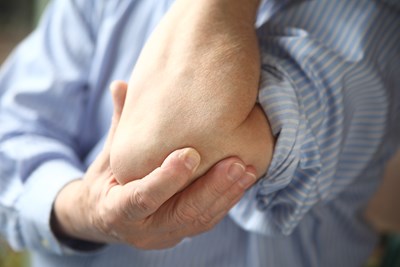Tennis elbow, also called tendonitis, is a condition that occurs from continuous stress or overuse of the muscles and tendons in the forearm. Pain is often felt on the outside of the elbow. Here is a look at everything you need to know about this common injury, including symptoms, causes, diagnosis, and treatments.
Symptoms
The most common symptom of tennis elbow is pain and tenderness felt on the outside of the elbow. The injured tendons are connected to this area, which is why it often hurts. Pain can also radiate up or down the arm. Though the injury is in the elbow, it is likely to hurt when using the hand and wrist as well. Pain will increase when lifting, making a fist, gripping an object, opening a door, shaking hands, raising your hand, or straightening your wrist.
Causes
Tendon overuse and impaired healing of the strained tendon causes tennis elbow. The injury is gradual, developing over time due to repetitive motions and stress on the muscles and tendons. The constant straining can cause microscopic tears in the tissue.
Although “tennis” is found in the name of the condition, it can be caused by other sports, as well as non-related sports activities. Tennis elbow can be the result of tennis, racquetball, squash, fencing, lifting weights, carpentry, typing, painting, raking and even knitting.
Diagnosis
If you are showing signs of tenderness and pain, consult with a physician. A doctor will apply pressure to the affected area while asking you to move your elbow, wrist, and fingers. Diagnostic tests are also used when tennis elbow is suspected. An X-ray can eliminate other possible injuries, such as a fracture or a break, while an MRI will show excess fluid and swelling in the damaged area in the elbow.
Treatments
In most cases, the injury will take care of itself over time, but there are recommended ways to help the healing process. Pain and inflammation can be reduced by icing the elbow for 20 to 30 minutes every 3 to 4 hours for 2 to 3 days, or until the pain subsides.
To prevent further injury to the tendon, using an elbow strap is recommended. Over-the-counter pain medication like aspirin or ibuprofen can help with both pain and swelling. They can, however, also cause side effects such as bleeding and ulcers. Therefore, only take them occasionally, unless advised otherwise by a doctor.
Physical therapy to strengthen and stretch the muscles is also beneficial. It helps reduce stiffness and increases flexibility.
In severe cases, if the injury does not respond to treatment after two to four months, surgery may be needed to remove the damaged part of the tendon and repair the remaining sections. Surgery is needed in about half of the cases of tennis elbow and is successful in 85% to 90% of the time.



